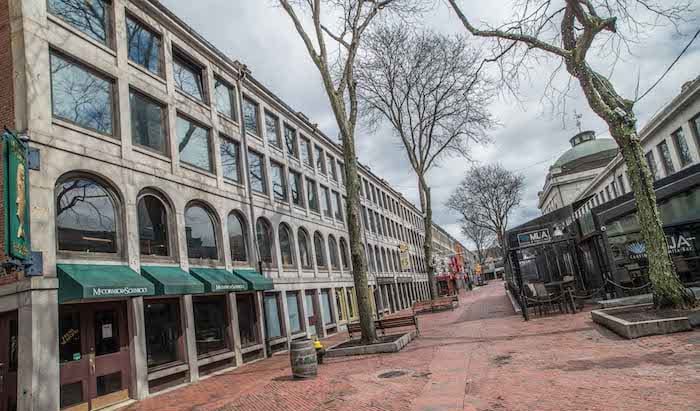
Nearly two years into the pandemic, it feels in some ways that dining and drinking spots are back to square one. But there are differences this time around
It’s Friday night, and it’s chilly out. A walk through the streets of Boston shows a disturbingly high number of parking spots available, mostly empty sidewalks, and a mix of busy and quiet restaurants, but at least in some parts of the city, the empty places seem to outnumber the jam-packed places. And it feels a lot like December of 2020—or in some ways, March of 2020—once again, with more than a few restaurant owners and workers painting a grim picture of the local dining scene. The former wonders how the bills will be paid while the latter continues to wonder if this is even the right industry to be in. But while upon first glance it feels like déjà vu as the new year approaches, there may be some reason for hope, as the situation is actually quite different this time around.
This spring, there did appear to be some hope that COVID was getting under control, as the vaccine rollout seemed to coincide with a drop in the number of cases. But some warning signs started flashing during the heat of the summer, and by August and September, the numbers were sharply rising once again. Now with the Omicron variant exploding across the country and becoming the dominant strain, a brief plateau in cases quickly became just a memory, as the number of cases appears to be heading toward—or surpassing—those that we saw last December and early this year. Because Omicron seems to be much more contagious than the Delta variant (which hit the United States hard and fast this summer), we seem to be back into a “fear of the unknown” state of mind right now, which certainly recalls memories of March of 2020 once again. There are signs, however, that the new variant, while being extremely easy to pass from person to person, may be a milder form of the virus than the Delta, which has resulted in some very cautious optimism: Could it be that huge numbers of people catch it but many if not most never getting sick enough to head to the hospital? Maybe, which is why Boston and other communities are keeping a very close eye on things while also taking some steps to lessen any potential dangers.
In the wee hours of Dec 20, rumors started flying about what exactly Boston’s new Mayor Michelle Wu might be announcing in her 10 AM update. One rumor turned out to be true, as she explained the next round of precautions that included a new mandate in which customers who wish to dine indoors at restaurants or bars will need to show proof of at least one dose starting Jan 15 for those aged 12 and up, and proof of two doses starting on Feb 15, while restaurant workers will need to prove that they have gotten the shots as well. The vaccine mandate for restaurants isn’t an entirely new concept, as other cities around the country (including Philadelphia, New York City, Los Angeles, and San Francisco) have either instituted vaccine mandates for indoor dining or will soon be rolling them out, but in the Greater Boston area, such a sweeping mandate is definitely a new concept, other than some local dining spots deciding to do it on their own.
Other communities in the region are undoubtedly looking closely at Boston’s recent decision, and it wouldn’t be a surprise—especially with such a sharp rise in cases—to see at least some cities and towns following suit, though there is no indication that a statewide mandate could be put in place at this point in time, nor a statewide mask requirement for that matter. In fact, many communities in Eastern Massachusetts continue to resist setting up a mask mandate, which is causing confusion because many other cities and towns do have such a mandate in place and often, you won’t know for sure what the policy is until physically going into a restaurant, market, or pharmacy and looking around. As a result, you have Boston, which has a mask mandate for restaurants and soon, a vaccine card mandate, while you have other cities and towns with a mask mandate but no vaccine mandate, and still others with neither, which could lead to an odd type of segmentation in which anti-vaxxers (and anti-maskers) may seek out communities with lax rules for dining, while those who have gotten their shots and regularly wear masks will probably see Boston as a safer option for going out to eat, along with other cities and towns that ultimately follow Boston’s lead on requiring proof of vaccination.
While there is much talk about vaccines, masks, and mandates, the bottom line is, no matter what kinds of rules are put in place and no matter how much restaurants try to show that they are safe, will diners come? We saw last winter that people tend to find their own comfort zones when it comes to the virus and no amount of convincing by restaurant owners or arguing on community Facebook pages will change people’s minds. In other words, the virus itself is making the decision in many cases, and depending on how things play out with the Omicron variant, it’s possible that takeout and delivery will once again rule the roost, which potentially means another winter of empty dining rooms, temporary closures, and laid-off workers, especially if the Restaurant Revitalization Fund isn’t replenished (and it’s by no means a given that it will be).
So what happens if the virus continues to spike, people decide not to dine indoors (even with vaccine/mask mandates), and the government doesn’t offer grants or loans? Once again, it would seem that suburban restaurants may fare better than those in the city in general, especially if people outside of Boston decide to keep working from home. And once again, areas that have a lot of office space such as Boston’s Financial District and Cambridge’s Kendall Square could be worse off than more residential urban neighborhoods such as the South End, Dorchester, Jamaica Plain, Coolidge Corner in Brookline, and North Cambridge—and areas that rely at least in part on tourism such as Faneuil Hall, the North End, and Harvard Square could see a real drop off in business.
As noted earlier, takeout and delivery are not going away no matter what, so dining spots will need to cater to those who opt to stay at home. And because endless takeout and delivery can lose its luster pretty quickly, convenience stores, local markets, and delis should do all right, as well as those relatively few restaurants that also sell produce, cold cuts, and the like. One development that we saw last winter—restaurants “hibernating” for a few months—seems to be in the works again, though in a more limited form, as a number of dining spots have now announced that they will be shut down for a spell, with most (for now) saying that they will close for the holidays and reopen sometime in January. Finally, while outdoor dining continues to be an option for some places over the next few months, the types of setups that include heated igloos, fire pits, and high-end heat lamps may attract some diners, but it’s by no means a magic bullet, in part because all it takes is a major snowstorm or two to put at least a temporary end to al fresco dining.
It’s really disheartening to be barreling toward year three of the pandemic with more questions than answers, but if people continue to get vaccinated/boosted and the Omicron variant turns out to be a mild strain of COVID, it’s possible that by the spring at least, the restaurant industry could finally start turning a corner (though the elephant in the room may continue to be a lack of workers). Only time will tell when it comes to how dining and drinking spots fare in early 2022, and these next few weeks should certainly tell us a lot now that Omicron is as firmly in place as the cold weather.
Marc is the founder of @hiddenboston, a textbook editor, a hike leader for @AppMtnClub, and a food and travel writer and commenter for DigBoston, NBC/NECN, WBZ, WMFO and indie617.

